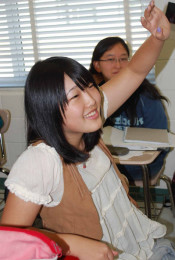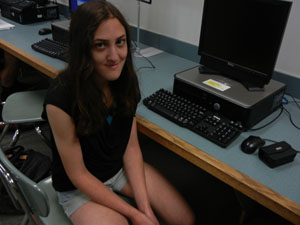Imagine arriving in a new country and being surrounded by people who do not speak your language. You hear foreign words coming at you from every direction all day long. Meanwhile, you attend a class that teaches you the new language, but all the instruction you receive is in that other language.
WJ’s English for Speakers of Other Languages (ESOL) department serves as a transition to the English language. It is designed to assist foreign students, who all have slightly different degrees of English knowledge.
“I love ESOL classes,” said sophomore and level five student Yuina Yamane. “People in ESOL classes are in the same situation as me. We’re like a team.”
Although she had already learned English at her school in the Philippines, level five sophomore Nicole Biquil felt that her transition to the U.S., with the help of the ESOL department, was smooth.
“I began to adapt to [ESOL Four after the second semester of my freshman year],” she said.
Similarly, level two ESOL student Parishad Barnoshian, who is from Iran, found that she grasped English better by being in ESOL.
There are 108 ESOL students at WJ, and that number can change from day to day as new students arrive and depart for their native countries. The department, comprised of Resource Teacher Young Pahk and teachers Suzan Borno and Irene Aluker, is filled with students from 35 countries, speaking a total of 21 different languages. However, whatever may be their native language, the speed at which students are able to learn English depends on their own dedication and effort. As in other subjects, the process of learning English involves the hard work of students, as well as the help and support of their teachers.
“I love teaching and I love acting,” said Borno, who teaches ESOL 2 and the preparatory class for the Test of English as a Foreign Language (TOEFL), the equivalent of the SAT for non-native English speakers.
Borno performs different gestures and accents to make learning English more interesting and comprehensive for her students. She finds her job to be unique because of the internationality of her students. Pahk, who teaches levels four and five, is a Korean speaker who is still trying to master the English language.
“[I find it] fascinating to be in the same boat [as my students, who cope] with the same burden I face every day,” said Pahk. Still, teaching students who speak a wide range of languages is not an easy task.
ESOL students come from different backgrounds, and they are gradually exposed to the English language, both in class and outside. They begin to gather vocabulary on their own as they learn new words in class. Through the WJ Culture Club, students are paired with others who speak their language , and in class they work together in groups to practice English. If they do not understand something, students often meet with their teacher outside of class.
“[This method of learning is] better because [students] do not depend on their [native] language[s] to access English,” said Pahk.
There are five levels of ESOL, including a bridge class between ESOL and English 10. However, there are some students who take English and ESOL simultaneously. In addition, 34 students are taking at least one AP class. The ESOL Department also offers ESOL U.S. History, Algebra, Modern World History, NSL Government, and a preparation class for the TOEFL, the test non-native English speakers take in order to attend a university in the U.S.
“I have to study really hard,” said Yamane, who is taking AP NSL Government. She sees a difference in her ability to write long essays in English compared to other students in her AP class.
WJ ESOL has consistently been full of students from diverse places. Some of the ESOL students move to the U.S. for a few years, because of their parents’ jobs, while other students’ families immigrate for economic opportunity and a better education. ESOL students come from countries as well-known as France and Japan and as exotic as Senegal, Madagascar and Burundi. They speak all kinds of languages, from Spanish and Russian to Kinyarwanda, Kmer and Tibetan.



































